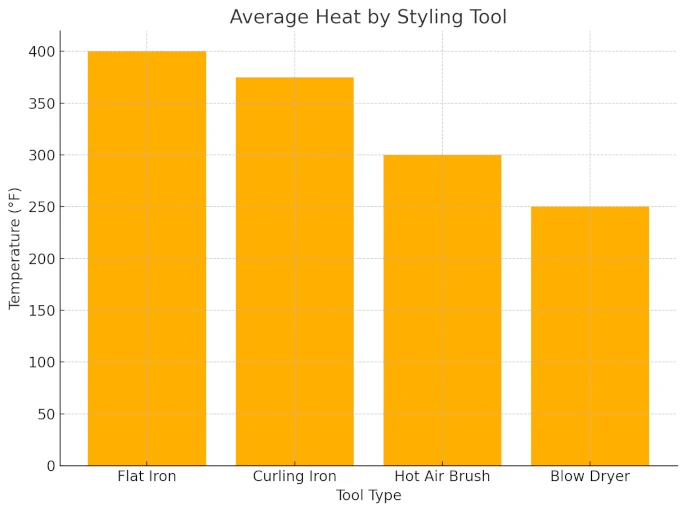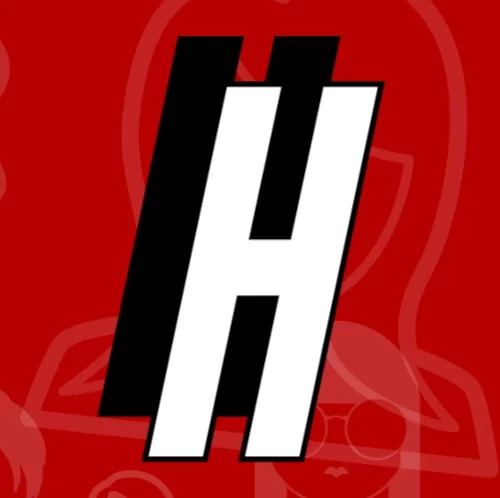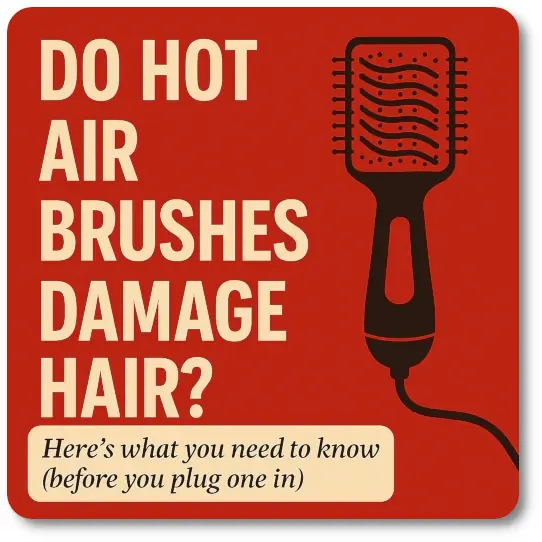Folks, Here’s the Deal…
Short Answer:
Hot air brushes can cause damage but far less than flat irons or curling wands when used properly. They use lower heat, apply less pressure, and combine drying with styling. The key is using them on dry or slightly damp hair, applying heat protectant, and avoiding aggressive brushing.
I’ve been in the haircare game long enough to remember when hot rollers were all the rage. And now? Hot air brushes are having their moment. But with all the buzz comes a fair question: Can these tools actually damage your hair?
The short answer? Yes if you’re combining high heat with mechanical tension, damage is absolutely possible. That mix can lead to things like bubble hair deformity, where trapped moisture turns to steam and weakens your strands from the inside out. But don’t stress I’ll break it down (without the fluff) so you can style smarter, protect your cuticles, and avoid turning your hair into brittle straw.
🎥 Watch: Do Hot Air Brushes Damage Hair? Faceless Short Explainer
Which Hot Air Brush is Best for You?
🔥 Heat Damage from Hot Air Brushes: What You Should Know

All heated styling tools can harm hair by:
- Stripping moisture from the hair shaft
- Damaging the protective cuticle layer
- Weakening protein bonds inside the cortex
But hot air brushes usually operate at 250–350 °F well below the 400–450 °F of flat irons.
| Tool | Average Heat | Risk Level |
|---|---|---|
| Flat Iron | 375–450 °F | 🔥🔥🔥 High |
| Curling Iron | 350–400 °F | 🔥🔥🔥 High |
| Hot Air Brush | 250–350 °F | 🔥🔥 Moderate |
| Blow Dryer | 125–250 °F | 🔥 Low–Medium |
🧠 Mechanical Damage: The Hidden Culprit

Even at low heat, pulling and friction from brushing can break hair, especially when:
- Tugging through tangles
- Using too-small sections
- Styling wet, fragile strands
👉 Gentle handling is just as important as heat level.
💡 How to Use a Hot Air Brush Without Damaging Hair
Follow these best practices to protect your hair:
- ✅ Always apply heat protectant before use
- ✅ Start on the lowest heat setting that still styles your hair
- ✅ Dry hair 70–80% first never use on soaking wet hair
- ✅ Avoid pulling or over-brushing the same section
- ✅ Use the cool shot function to set style and reduce frizz
- ✅ Clean the brush regularly to prevent heat blockage
What Exactly Is a Hot Air Brush?
If a hair dryer and a round brush had a baby, this would be it. Hot air brushes dry and style at the same time, blowing heated air through vents in the barrel while you brush your hair. Some rotate. Some don’t. Some get hot enough to fry bacon. Others barely get warm enough to melt butter.
They’re great for:
- Adding volume
- Light smoothing
- Curling under ends
- Quick styling on dry or damp hair
But like any tool that uses heat, there’s a line between smooth and scorched.
How Can Hot Air Brushes Damage Hair?
Here’s where things get serious, folks.
1. Overheating Wet Hair
Hot air on soaking wet strands? Bad idea. That sizzling sound you hear? That’s moisture inside the hair shaft turning to steam. It can cause something called bubble hair deformity. Tiny bubbles form inside the strand, weakening it. Imagine blowing air into a spaghetti noodle. It doesn’t end well.
Pro Tip: Let your hair air dry to about 80% before grabbing the hot air brush.
2. Too Much Tension
Yanking the brush through tangled hair = breakage. Especially if your hair’s on the finer or fragile side.
What to do instead: Detangle first with a wide-tooth comb or soft paddle brush. Your cuticles will breathe a sigh of relief.
3. Cranking Up the Heat Too High
Some brushes don’t even have temperature controls just “on” and “extra crispy.” Using max heat regularly is asking for dryness, split ends, and eventually, the dreaded frizz halo.
What I Recommend:
- Stick to low to medium heat unless you’ve got thick or coarse hair.
- Always and I mean always use a heat protectant.
How to Use a Hot Air Brush Without Wrecking Your Hair
Let’s cut through the noise. Here’s how I coach folks to use these safely:
✅ Towel-dry your hair first. Aim for damp, not dripping.
✅ Section your hair. Smaller sections = less stress on each strand.
✅ Keep it moving. Don’t linger in one spot too long or your hair will feel it.
✅ Choose ceramic or tourmaline barrels. They distribute heat evenly and cut down on hot spots.
✅ Watch for smell or steam. That’s your warning sign, not a feature.
Who Should Skip the Hot Air Brush?
Let’s be real, hot air brushes aren’t for everyone.
🙅♀️ If your hair is:
- Very curly or coily (4b/4c)
- Chemically treated or extremely fragile
- Super short (less than 3 inches)
…then a hot air brush might not give you the control or safety you need. A good blow dryer with a nozzle and round brush or even a flat iron might suit you better.
🔄 Alternatives to Heated Styling
Want to skip heat entirely? Try:
- Heatless curl wraps
- Overnight braids for waves
- Air-drying with curl cream or mousse
- Velcro rollers for volume
These options eliminate heat damage altogether.
⚖️ Hot Air Brush vs. Flat Iron: Which Is Safer?
“I noticed way less split ends after switching from a flat iron to a hot air brush.” – Reddit user /r/HaircareScience
Hot air brushes smooth and style with airflow and low heat – not hot metal plates. That means:
- ✅ Less direct heat exposure
- ✅ No harsh clamping pressure
- ✅ Fewer hot spots
Winner for daily use: Hot air brush
Winner for pin-straight styles: Flat iron (but more damage risk)
Final Verdict: Hot Air Brushes Can Be a Game-Changer If You Know What You’re Doing

I’ve tested dozens of these tools over the years. Some are beasts. Some are busts. But used right, a hot air brush can save you time, reduce arm fatigue, and leave you with smooth, styled hair without frying it into oblivion.
Just remember: like any tool, it’s not magic. It’s technique + smart product choices + heat awareness.
And if you’re ever in doubt? Drop me a line. I’ve probably tested that brush already.
Ed’s Take
“Styling without heat protection? That’s like sitting in a room with a grenade and the pin already pulled.”
Ed Shears
💬 Pro Tip from a Stylist
“We tell clients to treat hot air brushes like styling tools not dryers. Prep with protectant, dry first, and style gently.” – The Warehouse Salon
🙋♀️ Frequently Asked Questions (FAQs)
Q: Can I use a hot air brush on wet hair?
A: Only if it’s designed for wet-to-dry styling. Most models work best on towel-dried or nearly dry hair.
Q: Does hair type matter?
A: Yes. Fine or color-treated hair is more fragile always use a lower heat setting.
Q: Are all hot air brushes the same?
A: No. Look for:
- Ceramic barrels for even heat
- Mixed bristles for grip and shine
- Multiple heat settings and cool shot
Q: Will a hot air brush straighten curly hair?
A: It can smooth waves and curls, but won’t flatten type 3–4 curls like a flat iron would.
References:

